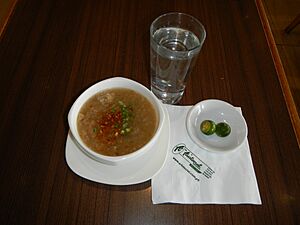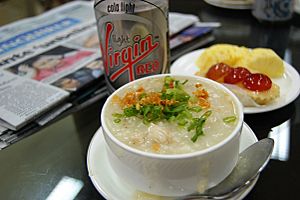Arroz caldo facts for kids

Chicken arroz caldo with kasubha
|
|
| Alternative names | Aroskaldo, caldo de arroz, arroz caldo con pollo, chicken arroz caldo, chicken pospas |
|---|---|
| Course | Main dish |
| Place of origin | Philippines |
| Region or state | Luzon |
| Serving temperature | Hot |
| Main ingredients | glutinous rice, ginger, chicken, toasted garlic, scallions, black pepper, safflower |
| Variations | pospas, arroz caldong palaka |
| Similar dishes | Goto, lugaw, Congee |
Arroz caldo, also called Aroskaldo, is a yummy Filipino rice and chicken soup. It's packed with the warm taste of ginger. This comforting dish is usually topped with crunchy toasted garlic, fresh scallions, and black pepper. You often add a squeeze of calamansi (a small citrus fruit) or a splash of fish sauce (patis) to make it even tastier. Many versions also include safflower (kasubha), which gives the soup its special yellow color. In some parts of the Visayas region, it's known as pospas, though the ingredients can be a little different.
Arroz caldo is a type of lugaw, which is a general term for rice porridge. Filipinos love it as a comfort food, especially for breakfast. It's also popular when the weather is cool or rainy, or when someone isn't feeling well.
Contents
What's in a Name? The Story of Arroz Caldo
The name Arroz caldo comes from two Spanish words: arroz meaning "rice" and caldo meaning "broth." Long ago, this name was used for all kinds of rice porridges in the Philippines. These porridges are called lugaw in the Tagalog language.
Over time, Arroz caldo became the special name for this specific type of lugaw. It's the one that always has chicken and lots of ginger. Even though it has a Spanish name, Arroz caldo actually started from congee. Congee is a similar rice porridge brought to the Philippines by Chinese-Filipino migrants. Over many years, Filipinos changed the recipe to use local ingredients and flavors.
How Is Arroz Caldo Made?

Arroz caldo usually uses a sticky type of rice called glutinous rice (malagkit). But you can also make it with regular rice. The rice is boiled with a lot of water until it becomes a thick, creamy porridge.
First, chicken pieces are cooked in a broth with plenty of fresh ginger. Once the chicken is tender, it's taken out and shredded into smaller pieces. Then, the shredded chicken is added back to the pot with the rice. The mixture is stirred often while cooking. This stops the rice from sticking to the bottom of the pot.
What Gives Arroz Caldo Its Color?
The bright yellow color of Arroz caldo comes from adding kasubha (safflower). Safflower is a plant whose petals are used for color. In more expensive versions, a spice called saffron might be used. Saffron not only adds color but also a special flavor. If neither safflower nor saffron is available, some people use turmeric instead. Turmeric is another spice that gives a yellow color.
Serving and Enjoying Arroz Caldo
Arroz caldo is served hot in individual bowls. Each bowl often has a single hard-boiled egg on top. It's usually garnished with crispy toasted garlic, freshly chopped scallions, and a sprinkle of black pepper. Sometimes, crumbled chicharon (crispy pork rinds) are added for extra crunch and flavor.
While Arroz caldo smells wonderful, it's often quite mild in taste on its own. That's why people love to season it with different condiments. The most common ones are calamansi and fish sauce (patis). You can also use lime or lemon if you don't have calamansi.
This dish is a true comfort food in Filipino cooking. People often eat it for breakfast, especially when it's cold or rainy outside. It's also a popular choice for people who are sick or need a warm, easy-to-eat meal. It's best eaten hot or warm, because it can get thick if it cools down too much. If it does get too thick, you can easily reheat it by adding a little water.
Different Kinds of Arroz Caldo
In the Visayas regions of the Philippines, savory lugaw is called pospas. Chicken pospas is very similar to Arroz caldo. However, a main difference is that pospas traditionally does not use safflower for color.
A very rare type of Arroz caldo is arroz caldong palaka. This version uses frog legs! The word palaka means "frog" in Tagalog. There are also newer versions for people who don't eat meat. These vegan versions might use mushrooms or tofu instead of chicken.
Another related dish is Goto. While it's also a type of lugaw, it's considered different from Arroz caldo. This is because Goto doesn't rely heavily on ginger. Instead, Goto is made with beef tripe (part of a cow's stomach). The tripe is soaked and boiled for many hours until it's very soft. Goto is sometimes called arroz caldo con goto or arroz con goto. The word goto means "tripe" in Tagalog.


